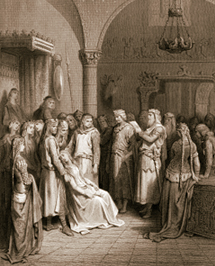King Edward I - Part 2
During the early years of Edward's childhood, Henry and his young family really did enjoy a level of comfort which most people in our modern age would not regard as medieval. Edward was dressed in expensive silks and fur trimmed robes and clothing decorated with gold. He ate from silver plates. By all accounts Henry was a good and caring father and spent as much time as he could at Windsor with his family. The Queen had plenty of help in raising all her children (in the year 1240 a sister had been born christened Margaret and a few years later came Beatrice born in Bordeaux during a royal trip to France; then a second son arrived at the start of 1245 and this child was named baby Edmund). The main help in raising all these children came from Hume and Sybil Gifford, a husband and wife team entrusted with Edward's care from the moment of his birth -- indeed Sybil had helped to deliver Edward! Edward also had two nurses Alice and Sarah who probably would have had the additional responsibility of suckling him.
 Little is known of Edward's education but it is believed that Hugh Gifford was probably the boy's teacher although he did in fact die before Edward's seventh birthday. Although growing up in a French-speaking environment, Edward would have learned English from an early age probably from his native born guardians the Giffords. Edward would also have had a thorough grounding in history and indeed particularly the history of his own family with some of its larger-than-life characters such as Richard the Lionheart, Edward's great uncle as well as undesirable characters such as his grandfather King John. Of course images of Edward the Confessor would never be far away as Henry III filled his palaces with images of his favourite saint!
Little is known of Edward's education but it is believed that Hugh Gifford was probably the boy's teacher although he did in fact die before Edward's seventh birthday. Although growing up in a French-speaking environment, Edward would have learned English from an early age probably from his native born guardians the Giffords. Edward would also have had a thorough grounding in history and indeed particularly the history of his own family with some of its larger-than-life characters such as Richard the Lionheart, Edward's great uncle as well as undesirable characters such as his grandfather King John. Of course images of Edward the Confessor would never be far away as Henry III filled his palaces with images of his favourite saint!
Edward's mother Eleanor was a great reader of medieval romances, that is to say tales of chivalry. At this time in every part of Europe, by far the most popular romantic tales were those set in ancient Britain: the tales of King Arthur and his Knights of the round table. The stories were much enjoyed for amusement typically being full of action and in them, heroes were praised for their prowess in tournaments and their ability to dispatch enemies on the battlefield. However, these stories also had an important moral message to convey: celebrating the noble virtues that secular aristocratic society would hold dear. The stories of King Arthur and his Knights of the round table put over the qualities of courage and loyalty, generosity and honesty.
Picture above right: Vintage engraving showing King Athur reading the letter from Elaine in a scene from Arthurian Legend.
After the death of Hugh Gifford in 1246, Edward was put under the care of Bartholomew Pecche, the knight who had earlier been responsible for the little Margaret's welfare; it was probably under Bartholomew that Edward would have begun to acquire the skills which he illustrated in later life such as how to gallop a horse, how to train and track hawks, how to hunt and also very probably how to handle knives and swords.
When Edward was around 14 years old, his father Henry III set off to quell a rebellion in his ancestral land of Gascony in France. A cunning Spanish King named Alfonso the 10th had been supporting rebels, he himself having a dubious claim to the ownership of this province. Henry travelled to the area and had considerable success in putting down the Gascon rebels; by the beginning of the year 1254, Alfonso was ready to settle, agreeing to drop his claim to Gascony in return for a marriage alliance whereby his young half-sister also named Eleanor would have to marry Henry's eldest son, Edward. Alfonso demanded that Edward be endowed with lands worth £10,000 a year and Henry issued a charter in effect giving Edward Gascony but in order to meet Alfonso's £10,000 a year, Henry also added the lapsed earldom of Chester, the Castle of Bristol, and number of important properties in the Midlands. Soon Edward had become the richest landowner in Henry III's realm after the king himself. Not long afterwards, Edward and Eleanor who was in fact a few weeks short of her 13th birthday, were married in Castille.
By the age of 16, Edward had gained the physical attributes for which he was later to become famous being broad browed, broad-chested with blonde hair and a strikingly handsome face. In spite of his having inherited a drooping eyelid from his father, he was most noticeably very tall for his time. An 18th-century exhumation of his body confirmed that he was in fact 6'2" tall and this of course is the origin of the popular nickname "Longshanks"


